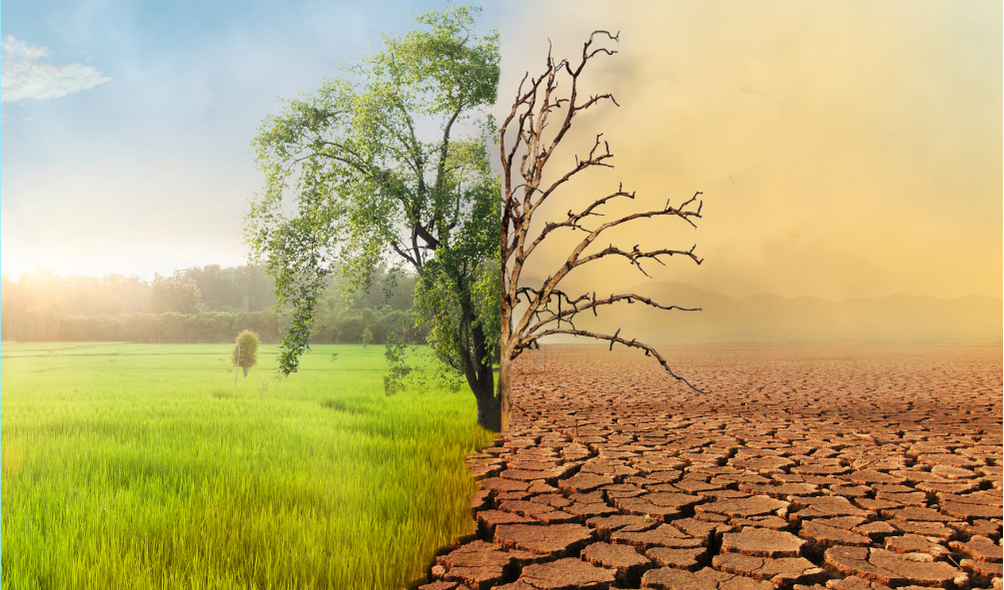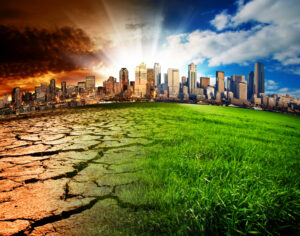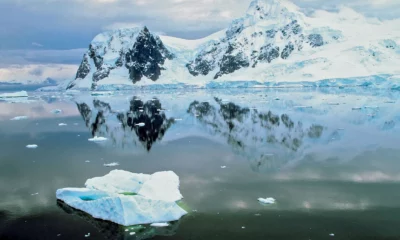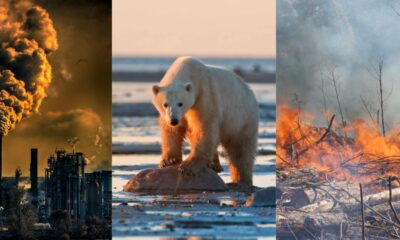NEWS
Climate Change: Understanding the Global Challenge

Climate change is one of the most pressing challenges facing humanity in the 21st century. It refers to the long-term alteration of the Earth’s climate due to human activities and natural processes. The increase in greenhouse gas emissions, deforestation, and industrialization are among the primary contributors to this phenomenon. In this article, we will delve into the various aspects of climate change, providing detailed insights into its causes, impacts, and potential solutions.
Understanding Climate Change

Climate change encompasses a range of complex topics that must be examined to grasp its full implications. Below, we break down the key elements of this global challenge:
1. The Science Behind Climate Change
To comprehend climate change fully, we need to understand the scientific principles behind it. Climate change is primarily driven by the greenhouse effect, where certain gases in the atmosphere trap heat and cause the planet’s temperature to rise. Carbon dioxide (CO2), methane (CH4), and nitrous oxide (N2O) are the major greenhouse gases, and their concentrations have increased significantly since the industrial revolution.
2. Causes of Climate Change
Human activities are the primary drivers of recent climate change. The burning of fossil fuels for energy, deforestation, and industrial processes release vast amounts of greenhouse gases into the atmosphere, intensifying the greenhouse effect. Additionally, natural factors, such as volcanic eruptions and solar radiation fluctuations, can influence climate variations over long periods.
3. Impact on Weather Patterns
Climate change affects weather patterns worldwide, leading to more frequent and intense extreme weather events. Heatwaves, droughts, heavy rainfall, and hurricanes have become more prevalent, posing significant risks to communities, ecosystems, and economies.
4. Melting Ice Caps and Rising Sea Levels
As the Earth’s temperature rises, polar ice caps and glaciers are melting at an alarming rate. This has resulted in the rise of sea levels, threatening coastal regions and low-lying islands. The loss of ice also disrupts the habitats of various species, endangering their survival.
5. Ocean Acidification
Increased CO2 levels in the atmosphere not only warm the planet but also get absorbed by the oceans, causing them to become more acidic. Ocean acidification negatively impacts marine life, especially organisms with calcium carbonate shells, like coral reefs and mollusks.
6. Biodiversity Loss
Climate change leads to shifts in ecosystems and habitats, affecting biodiversity. Many species struggle to adapt or face extinction due to changing environmental conditions. Preserving biodiversity is crucial to maintaining ecological balance and sustaining life on Earth.
7. Socio-Economic Impacts
Climate change also has profound socio-economic consequences. Disruptions in agriculture, water resources, and public health can strain communities and lead to migration and conflicts. Vulnerable populations, including the poor and marginalized, are often disproportionately affected.
8. International Agreements and Policies
Recognizing the severity of climate change, governments and organizations worldwide have come together to address the issue through international agreements and policies. Prominent examples include the Paris Agreement and the United Nations Framework Convention on Climate Change (UNFCCC).
9. Renewable Energy Solutions
Transitioning from fossil fuels to renewable energy sources, such as solar, wind, and hydropower, is a crucial step in mitigating climate change. These sustainable alternatives offer a greener and more sustainable future.
10. Sustainable Practices and Green Initiatives
Apart from adopting renewable energy, individuals, businesses, and governments can make a significant impact by adopting sustainable practices. This includes energy conservation, waste reduction, and supporting green initiatives.
11. Technological Innovations for Climate Resilience
Advancements in technology have enabled the development of innovative solutions for climate resilience. From climate modeling and early warning systems to carbon capture and storage, these technologies play a vital role in adapting to and mitigating climate change.
12. The Role of Afforestation and Reforestation
Reforestation and afforestation efforts are essential for absorbing CO2 and combating deforestation. Trees act as carbon sinks, helping to offset greenhouse gas emissions and restore ecosystems.
13. Sustainable Agriculture and Food Security
Agriculture contributes to climate change through practices like deforestation and methane emissions. Embracing sustainable agriculture methods and reducing food waste can help address food security while combating climate change.
14. Climate Change and Public Health
Climate change has direct and indirect effects on public health. Extreme weather events can cause injuries and deaths, while changing disease patterns and air pollution can exacerbate health issues.
15. The Role of Individual Actions
Individual actions, no matter how small, collectively contribute to addressing climate change. Everyone can make a difference by adopting eco-friendly habits, promoting sustainability, and advocating for change.
16. Education and Awareness
Raising awareness about climate change is vital in fostering a sense of responsibility and urgency. Education at all levels can empower individuals to take informed actions and support environmental initiatives.
17. Climate Change and Global Politics
Climate change is a politically significant issue, as different countries have varying levels of responsibility and capacity to address it. International cooperation and diplomacy play a crucial role in finding common solutions.
18. Corporate Responsibility and Environmental Stewardship
Businesses have a critical role to play in addressing climate change. Corporate responsibility and environmental stewardship can drive sustainability practices and promote positive change in supply chains and operations.
19. Climate Change and Indigenous Knowledge
Indigenous communities often possess valuable traditional knowledge and practices that can contribute to climate change mitigation and adaptation efforts. Respecting and integrating their perspectives is crucial in shaping effective strategies.
20. Innovations in Transportation
The transportation sector is a significant source of greenhouse gas emissions. Advancements in electric vehicles, public transportation, and sustainable urban planning can lead to greener mobility solutions.
21. Climate Change and Economic Resilience
Investing in climate change resilience can enhance economic stability and protect communities from the financial repercussions of extreme weather events and environmental challenges.
22. The Role of International Funding and Support
Developing countries, especially those with limited resources, need international support and funding to combat climate change effectively. Financial assistance can aid in sustainable development and adaptation efforts.
23. Climate Change Adaptation Strategies
Adaptation strategies involve adjusting to the effects of climate change to reduce vulnerabilities and build resilience in communities, infrastructure, and ecosystems.
24. Promoting Sustainable Consumption
Consumers can contribute to climate change mitigation by making conscious choices, such as opting for eco-friendly products and reducing overall consumption.
25. Climate Change and Future Generations
The impact of climate change will be felt most by future generations. Taking decisive action today is vital to secure a sustainable and livable world for the generations to come.
Climate Change: FAQs
1. How Do We Know Climate Change is Real?
Climate change is supported by an overwhelming consensus among climate scientists who study long-term patterns and data related to temperature, ice melt, and sea-level rise. The evidence is backed by extensive research and observation.
2. Can Individuals Make a Difference in Combating Climate Change?
Absolutely! Every individual can contribute to fighting climate change by adopting sustainable practices, reducing waste, and supporting eco-friendly initiatives.
3. Is Climate Change Just a Natural Cycle?
While natural factors have influenced the climate in the past, the current rate of change is unprecedented and largely driven by human activities.
4. What is the Paris Agreement, and How Does it Help Combat Climate Change?
The Paris Agreement is an international treaty that aims to limit global warming to well below 2 degrees Celsius above pre-industrial levels. It encourages countries to submit voluntary climate action plans to reduce emissions and adapt to the impacts of climate change.
5. How Can I Help Raise Awareness About Climate Change?
You can raise awareness about climate change by educating yourself and others, using social media to share information, participating in environmental events, and supporting organizations that promote sustainability.
6. What Are the Main Challenges in Combating Climate Change?
The main challenges include global cooperation, overcoming vested interests in fossil fuels, financing sustainable projects, and ensuring equitable and inclusive climate policies.
Conclusion
Climate change is a complex and urgent global challenge that requires collective action from individuals, governments, and businesses. By understanding the science behind climate change, its causes, impacts, and potential solutions, we can work together to create a sustainable and resilient future. As stewards of the planet, it is our responsibility to take meaningful steps towards mitigating climate change and safeguarding the well-being of current and future generations.

climate change
NEWS
Unveiling the Mysteries of Pollaste: The Hidden Gems of Culinary Delight

Introduction to Pollaste
What is Pollaste?
Pollaste, also known as chicken, is a versatile poultry meat cherished for its tender texture and mild flavor. It has been a dietary staple for centuries, with its origins tracing back to ancient civilizations.
Historical Significance
Throughout history, Pollaste has played a crucial role in various cultures and cuisines. From ancient rituals to royal feasts, Pollaste has been a symbol of abundance and celebration.
Nutritional Value
Protein Content
Pollaste is renowned for its high protein content, making it an excellent choice for individuals seeking to boost their protein intake. It provides essential amino acids necessary for muscle repair and growth.
Other Nutrients
In addition to protein, Pollaste is a good source of essential vitamins and minerals, including B vitamins, iron, and zinc. These nutrients are vital for maintaining overall health and well-being.
Health Benefits
Promotes Muscle Growth
The protein-rich nature of Pollaste makes it an ideal choice for individuals looking to build and maintain muscle mass. Regular consumption of Pollaste can support muscle growth and repair.
Boosts Immune System
Pollaste contains various nutrients, such as vitamin B6 and zinc, which play a crucial role in immune function. Incorporating Pollaste into your diet can help strengthen your immune system and ward off infections.
Culinary Versatility
Different Cooking Methods
Pollaste can be prepared using a variety of cooking methods, including grilling, roasting, and braising. Each method brings out unique flavors and textures, allowing for endless culinary creativity.
Popular Recipes
From classic roast chicken to spicy chicken curry, Pollaste lends itself to a wide range of delicious recipes. Its mild flavor makes it a versatile ingredient that can be paired with various herbs, spices, and sauces.
Sourcing Pollaste
Where to Find It
Pollaste is readily available at supermarkets, butcher shops, and farmers’ markets. It is typically sold fresh or frozen, depending on your preference and convenience.
Fresh vs. Frozen
While fresh Pollaste is ideal for immediate consumption, frozen Pollaste offers convenience and longer storage life. Both options are equally nutritious and can be used interchangeably in recipes.
Preparation Tips
Thawing Instructions
If using frozen Pollaste, ensure proper thawing before cooking. Thaw it in the refrigerator overnight or use the defrost setting on your microwave for quick thawing.
Seasoning Suggestions
Before cooking, consider marinating Pollaste with your favorite herbs, spices, and seasonings to enhance its flavor. Popular options include garlic, lemon, rosemary, and paprika.
Cooking Techniques
Grilling
Grilling Pollaste imparts a smoky flavor and crispy texture, making it a favorite for outdoor gatherings and barbecues. Marinate the Pollaste beforehand and grill it over medium-high heat until cooked through.
Roasting
Roasting Pollaste in the oven results in tender, juicy meat with a golden-brown crust. Season the Pollaste with herbs and spices, then roast it at a high temperature until it reaches the desired doneness.
Braising
Braising Pollaste involves slow-cooking it in liquid until tender and flavorful. This method is perfect for tougher cuts of Pollaste and yields succulent meat that falls off the bone.
Pairing Suggestions
Wine Pairings
Pair roasted or grilled Pollaste with a crisp white wine, such as Chardonnay or Sauvignon Blanc. For richer dishes, opt for a medium-bodied red wine like Pinot Noir or Merlot.
Side Dishes
Complement Pollaste with a variety of side dishes, such as roasted vegetables, mashed potatoes, or a fresh salad. The possibilities are endless, so feel free to get creative with your pairings.
Cultural Significance
Traditional Dishes
Pollaste features prominently in many traditional dishes around the world, from American fried chicken to Indian butter chicken. These dishes often hold special cultural significance and are enjoyed during festive occasions.
Festive Occasions
In many cultures, Pollaste is served during celebratory gatherings and holidays. It symbolizes prosperity, abundance, and togetherness, bringing joy to family and friends.
Global Appeal
Pollaste in International Cuisines
Pollaste transcends cultural boundaries and is celebrated in cuisines from every corner of the globe. Whether it’s Thai chicken curry, Italian chicken Parmesan, or Moroccan chicken tagine, Pollaste takes on unique flavors and preparations in each cuisine.
Sustainability
Environmental Impact
As consumers become more conscious of environmental issues, sustainable sourcing of Pollaste is gaining importance. Look for products labeled as organic or free-range to support environmentally friendly practices.
Ethical Sourcing
Choose Pollaste from reputable producers who prioritize animal welfare and ethical farming practices. By making informed choices, you can support sustainable and humane treatment of poultry.
Myths and Misconceptions
Addressing Common Myths
Despite its popularity, Pollaste is often surrounded by myths and misconceptions. From concerns about hormones to misconceptions about freshness, it’s essential to separate fact from fiction.
Clarifying Misconceptions
Contrary to popular belief, most Pollaste in the market today is hormone-free, and freezing does not significantly impact its nutritional value or taste. By understanding the facts, you can make informed decisions about Pollaste consumption.
Exploring Alternative Uses
Pollaste in Non-Culinary Applications
Beyond the kitchen, Pollaste finds its way into various non-culinary applications, such as pet food, pharmaceuticals, and cosmetics. Its versatility extends beyond the dinner table, showcasing its multifaceted nature.
Consumer Tips
Storage Recommendations
Store fresh Pollaste in the refrigerator for up to two days or freeze it for longer-term storage. When freezing Pollaste, ensure it is properly sealed to prevent freezer burn.
Quality Indicators
When purchasing Pollaste, look for firm, moist meat with no noticeable odor. Avoid packages with excessive liquid or discoloration, as these may indicate spoilage.
Conclusion
In conclusion, Pollaste stands as a culinary treasure, offering not only delicious flavors but also a wealth of nutritional benefits. Its versatility and cultural significance make it a beloved ingredient in cuisines around the world. Whether you’re grilling, roasting, or braising, Pollaste is sure to delight your taste buds and nourish your body.
FAQs (Frequently Asked Questions)
- Is Pollaste the same as chicken?
- Yes, Pollaste is another term for chicken, commonly used in certain regions.
- Can I use frozen Pollaste in place of fresh?
- Absolutely! Frozen Pollaste is a convenient option and retains its nutritional value when properly stored and cooked.
- Are there any health risks associated with consuming Pollaste?
- As with any food, it’s essential to handle and cook Pollaste properly to reduce the risk of foodborne illness.
- What makes Pollaste a nutritious choice?
- Pollaste is rich in protein, vitamins, and minerals, making it an excellent addition to a balanced diet.
- How can I incorporate Pollaste into my meals?
- From soups and salads to stir-fries and sandwiches, Pollaste can be used in countless recipes to add flavor and nutrition.
NEWS
Cat in the Chrysalis: A Journey of Transformation and Redemption

Introduction
“Cat in the Chrysalis” is a captivating novel that has captured the hearts of readers worldwide with its gripping narrative and profound themes. In this article, we delve into the intricacies of this literary masterpiece, exploring its plot, characters, themes, and much more.
What is “Cat in the Chrysalis”?
“Cat in the Chrysalis” is a contemporary fiction novel penned by acclaimed author, [Author’s Name], published in [Year]. The novel follows the journey of [Protagonist’s Name], a troubled individual grappling with [brief description of protagonist’s struggle].
Main Characters and Setting
Protagonist
[Protagonist’s Name] is the central character of the story, portrayed as [brief description of the protagonist’s personality and background].
Antagonist
The antagonist, [Antagonist’s Name], serves as the primary obstacle to the protagonist’s goals, embodying [brief description of antagonist’s role and motivations].
Supporting Characters
Several supporting characters populate the world of “Cat in the Chrysalis,” each contributing to the narrative in unique ways.
Plot Summary
Beginning: Setting the Stage
The story commences with [brief description of the initial setting and conflict].
Middle: Rising Action
As the plot progresses, [description of key events leading to the climax].
Climax: Turning Point
The climax of the novel occurs when [brief description of the pivotal moment].
End: Resolution
The story concludes with [brief overview of how conflicts are resolved and character arcs completed].
Themes Explored
“Cat in the Chrysalis” explores several profound themes, including:
- Identity and Transformation:
- Loss and Grief:
- Redemption and Forgiveness:
Symbolism and Metaphors
Throughout the narrative, [brief analysis of symbolic elements and metaphors].
Critical Reception and Reviews
Critics and readers alike have praised “Cat in the Chrysalis” for its [brief overview of critical reception].
Analysis of the Ending (Spoiler Warning)
[Spoiler warning] The ending of “Cat in the Chrysalis” has sparked discussions and interpretations among readers. [Detailed analysis of the ending].
Impact and Legacy
The novel’s impact extends beyond its pages, [discussion of the book’s influence on literature and culture].
Comparisons to Other Works
In comparison to [mention of similar works], “Cat in the Chrysalis” stands out due to [highlight of unique aspects].
Author’s Inspiration and Influences
[Author’s Name]’s inspiration for “Cat in the Chrysalis” stemmed from [mention of author’s influences and motivations].
The Writing Process Behind “Cat in the Chrysalis”
[Insight into the author’s writing process and challenges faced during the creation of the novel].
Discussion of Controversial Elements (if applicable)
Some aspects of “Cat in the Chrysalis” have sparked controversy, [brief exploration of controversial themes or scenes].
Fan Theories and Speculations
Fans of the novel have crafted various theories and speculations regarding [mention of popular fan theories].
Conclusion
“Cat in the Chrysalis” transcends the boundaries of conventional storytelling, offering readers a thought-provoking journey of self-discovery and redemption. Its rich tapestry of characters, themes, and narrative depth continues to resonate with audiences worldwide, solidifying its place as a timeless literary masterpiece.
Unique FAQs
- Is “Cat in the Chrysalis” suitable for all ages?
- What makes “Cat in the Chrysalis” stand out among other contemporary fiction novels?
- **Does “Cat in the Chrysalis” have a sequel or spin-off?
- **Are there any film adaptations of “Cat in the Chrysalis” in development?
- **Where can I purchase a copy of “Cat in the Chrysalis”?
NEWS
What to Do When Filing for a Divorce in Anniston, Alabama

Divorce is a common experience for a lot of people in Anniston. But couples who are planning to get a divorce may not be aware of the steps to take to have legal proceedings. While such a process may seem simple, it can be complex. To learn more about getting a divorce in the state of Alabama, keep reading:
Meeting the Residency Requirements
Before you can file for a divorce, you need to meet the state’s residency requirements. If you and your spouse live in the state, you can file for a divorce whenever you like. If the filing spouse lives in the state; however, the other spouse doesn’t, the rules are not the same. The spouse who will file should have been living in Alabama for at least six months.
Picking a Legal Reason to File
To legally end your marriage in Anniston, you must have a reason such as adultery, addiction, or abuse. Proving that your spouse is responsible for the end of your marriage increases your chances of getting a bigger share of your marital assets. If adultery or abuse is not an issue in your marriage, you can file for a no-fault divorce. To do this, you can choose incompatibility or irretrievable marriage breakdown as grounds.
With a no-fault divorce, you do not have to prove your marriage is not working. But if you attribute the divorce to the behavior of your spouse, you must give evidence of this accusation to dissolve your marriage.
Filing the Divorce Papers
Divorce papers can include the reason for divorce, property and debt division, child custody arrangements, and other issues. Make sure to send copies of these papers to your spouse. To improve your chances of getting the court to approve your desired asset division and custody arrangements, speak with a skilled divorce attorney before you file the papers. Your attorney can assist you in getting your desired outcome for your divorce. Should your spouse fail to respond to the papers they were served within a certain period, they might lose the shared assets to you.
If your spouse does not agree with a part of the divorce papers, they can file opposing papers. When this happens, you go through a contested divorce. You and your spouse must make court appearances for this kind of divorce. But if you provided reasonable terms in the divorce papers, your spouse may accept them. In this case, you can finalize your divorce with little fuss.
-

 HEALTH2 years ago
HEALTH2 years agoDr. Naval Parikh: Thyroid Disease Signs, Symptoms & Treatment Options
-

 HEALTH2 years ago
HEALTH2 years agoDr. Naval Parikh: Back Injuries, Types, Causes, Symptoms and Treatment
-

 FASHION12 months ago
FASHION12 months agoBest Color Shoes for Men: Making a Style Statement
-

 TECH2 years ago
TECH2 years agoHow to Turn Flashlight On iPhone & Off, 3 Easy Ways
-

 TRAVEL1 month ago
TRAVEL1 month agomyfavouriteplaces.org:// Blog | Travel’s Best-Kept Secrets
-

 Celebrity2 years ago
Celebrity2 years agoDay 3 of Spring 2016 New York Fashion Week’s most inspiring
-

 GAMES2 years ago
GAMES2 years agoAbout Tekken 3
-

 APPS2 years ago
APPS2 years agoY2mate download videos from YouTube Facebook etc




